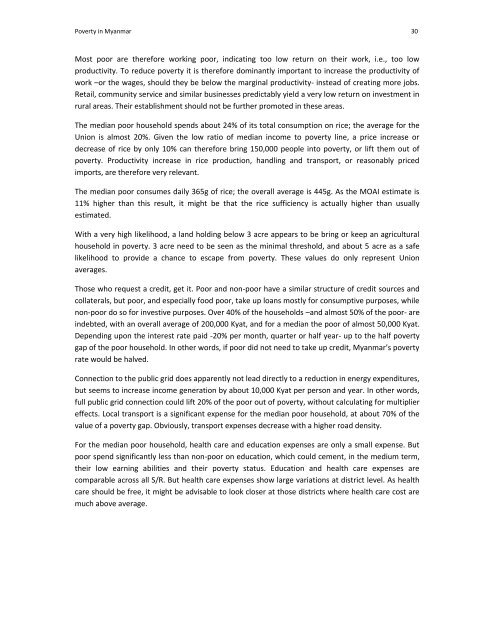A regional perspective on poverty in Myanmar - United Nations ...
A regional perspective on poverty in Myanmar - United Nations ...
A regional perspective on poverty in Myanmar - United Nations ...
You also want an ePaper? Increase the reach of your titles
YUMPU automatically turns print PDFs into web optimized ePapers that Google loves.
Poverty <strong>in</strong> <strong>Myanmar</strong> 30<br />
Most poor are therefore work<strong>in</strong>g poor, <strong>in</strong>dicat<strong>in</strong>g too low return <strong>on</strong> their work, i.e., too low<br />
productivity. To reduce <strong>poverty</strong> it is therefore dom<strong>in</strong>antly important to <strong>in</strong>crease the productivity of<br />
work –or the wages, should they be below the marg<strong>in</strong>al productivity- <strong>in</strong>stead of creat<strong>in</strong>g more jobs.<br />
Retail, community service and similar bus<strong>in</strong>esses predictably yield a very low return <strong>on</strong> <strong>in</strong>vestment <strong>in</strong><br />
rural areas. Their establishment should not be further promoted <strong>in</strong> these areas.<br />
The median poor household spends about 24% of its total c<strong>on</strong>sumpti<strong>on</strong> <strong>on</strong> rice; the average for the<br />
Uni<strong>on</strong> is almost 20%. Given the low ratio of median <strong>in</strong>come to <strong>poverty</strong> l<strong>in</strong>e, a price <strong>in</strong>crease or<br />
decrease of rice by <strong>on</strong>ly 10% can therefore br<strong>in</strong>g 150,000 people <strong>in</strong>to <strong>poverty</strong>, or lift them out of<br />
<strong>poverty</strong>. Productivity <strong>in</strong>crease <strong>in</strong> rice producti<strong>on</strong>, handl<strong>in</strong>g and transport, or reas<strong>on</strong>ably priced<br />
imports, are therefore very relevant.<br />
The median poor c<strong>on</strong>sumes daily 365g of rice; the overall average is 445g. As the MOAI estimate is<br />
11% higher than this result, it might be that the rice sufficiency is actually higher than usually<br />
estimated.<br />
With a very high likelihood, a land hold<strong>in</strong>g below 3 acre appears to be br<strong>in</strong>g or keep an agricultural<br />
household <strong>in</strong> <strong>poverty</strong>. 3 acre need to be seen as the m<strong>in</strong>imal threshold, and about 5 acre as a safe<br />
likelihood to provide a chance to escape from <strong>poverty</strong>. These values do <strong>on</strong>ly represent Uni<strong>on</strong><br />
averages.<br />
Those who request a credit, get it. Poor and n<strong>on</strong>-poor have a similar structure of credit sources and<br />
collaterals, but poor, and especially food poor, take up loans mostly for c<strong>on</strong>sumptive purposes, while<br />
n<strong>on</strong>-poor do so for <strong>in</strong>vestive purposes. Over 40% of the households –and almost 50% of the poor- are<br />
<strong>in</strong>debted, with an overall average of 200,000 Kyat, and for a median the poor of almost 50,000 Kyat.<br />
Depend<strong>in</strong>g up<strong>on</strong> the <strong>in</strong>terest rate paid -20% per m<strong>on</strong>th, quarter or half year- up to the half <strong>poverty</strong><br />
gap of the poor household. In other words, if poor did not need to take up credit, <strong>Myanmar</strong>’s <strong>poverty</strong><br />
rate would be halved.<br />
C<strong>on</strong>necti<strong>on</strong> to the public grid does apparently not lead directly to a reducti<strong>on</strong> <strong>in</strong> energy expenditures,<br />
but seems to <strong>in</strong>crease <strong>in</strong>come generati<strong>on</strong> by about 10,000 Kyat per pers<strong>on</strong> and year. In other words,<br />
full public grid c<strong>on</strong>necti<strong>on</strong> could lift 20% of the poor out of <strong>poverty</strong>, without calculat<strong>in</strong>g for multiplier<br />
effects. Local transport is a significant expense for the median poor household, at about 70% of the<br />
value of a <strong>poverty</strong> gap. Obviously, transport expenses decrease with a higher road density.<br />
For the median poor household, health care and educati<strong>on</strong> expenses are <strong>on</strong>ly a small expense. But<br />
poor spend significantly less than n<strong>on</strong>-poor <strong>on</strong> educati<strong>on</strong>, which could cement, <strong>in</strong> the medium term,<br />
their low earn<strong>in</strong>g abilities and their <strong>poverty</strong> status. Educati<strong>on</strong> and health care expenses are<br />
comparable across all S/R. But health care expenses show large variati<strong>on</strong>s at district level. As health<br />
care should be free, it might be advisable to look closer at those districts where health care cost are<br />
much above average.

















